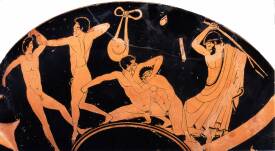| Olympia | Games | Events & athletes | Background | Impact |
 Already very early in their history, the Greeks practiced sport and because they exercised naked (Gr.: gymnos), the training area was called gymnasion. Only from the fourth century BC onwards, this training area was developed architecturally. We know very little about this originally private institution until about 330 BC.
Already very early in their history, the Greeks practiced sport and because they exercised naked (Gr.: gymnos), the training area was called gymnasion. Only from the fourth century BC onwards, this training area was developed architecturally. We know very little about this originally private institution until about 330 BC.
In the Hellenistic period the gymnasion gained importance. It moved from the outskirts of the city to the center and became an important meetingplace, a kind of 'second marketplace'. It developed into a large architectural complex with open and roofed rooms: a palaistra or wrestling pit, a dressing room, a room with a punching bag, a room with fine sand to wrestle when it was raining outside, an open and covered running track, a room for steam baths, bodily care and massages, dining halls, a library, etc.
At the same time the gymnasion was also a cult place with an altar and divine statues, usually of Hermes, Herakles or Apollo. Religious festivals with games were organized for these gods. Besides the normal events practiced at games such as the Olympics, these gymnasion games also had typical events for adolescents, such as a contest in endurance or in discipline and military events.
 The gymnasia also attracted famous orators, philosophers and scholars. Plato and Aristotle were the first to found a university in a gymnasion: the Academy (c. 385 BC) and the Lyceum (c. 335 BC). The element education gained considerable importance. Gymnasia of the Hellenistic period and the early imperial period functioned not only as sports center, but to some extent also as a kind of secondary school for rich boys of good descent. In Egypt, one had to submit long family trees to be accepted among 'those of the gymnasion'.
The gymnasia also attracted famous orators, philosophers and scholars. Plato and Aristotle were the first to found a university in a gymnasion: the Academy (c. 385 BC) and the Lyceum (c. 335 BC). The element education gained considerable importance. Gymnasia of the Hellenistic period and the early imperial period functioned not only as sports center, but to some extent also as a kind of secondary school for rich boys of good descent. In Egypt, one had to submit long family trees to be accepted among 'those of the gymnasion'.
The maintenance of the buildings and the free distribution of olive oil were very expensive. The presidents of the gymnasia, who often paid the oil from their own pockets, were honoured by the city for this, because the gymnasion had become a municipal institution.
As the most important institution for the physical and mental education of Greek citizens, the gymnasion became a symbol of Greek culture. For the citizens of newly founded Greek cities in the eastern Mediterranean, having a gymnasion was a point of honour. Even Ai Khanoum, a city at the edge of the Hellenistic Greek world located in present day Afghanistan, had a large gymnasion.
In the late imperial period, bodily care became the most important aspect of the gymnasia and 'gymnasion' gradually became just a synonym of 'bathhouse'.